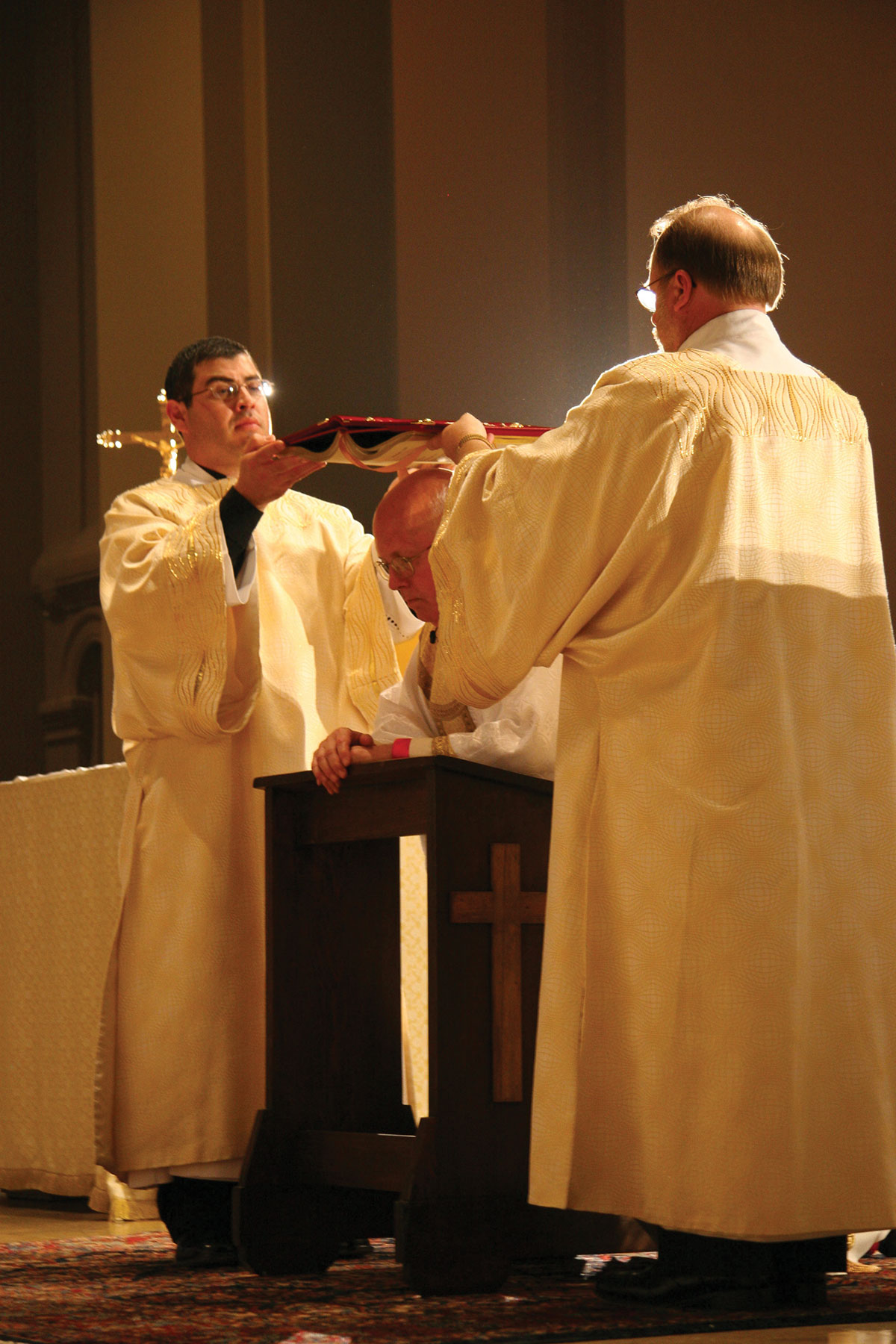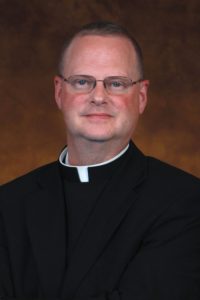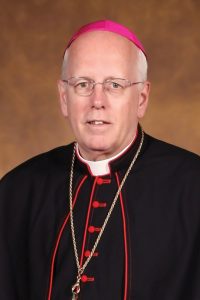
When I visit our Catholic schools the children are given the opportunity to ask me questions. Frequently they include: what does a bishop do or what is the best part about being a bishop? To the first question I often jokingly respond that I do not know; I haven’t been a bishop long enough. I do know that the best part of being a bishop is the best part of being a priest: to serve in persona Christi in the Holy Sacrifice of the Mass.
Another regular question is how do you become a bishop. To this with tongue in cheek I respond that it is one of the great mysteries of the Church. This is how I became a bishop.
In August 2006 I was in Salt Lake City, Utah visiting the beautiful Cathedral dedicated to Saint Mary Magdalene. The Cathedral in the Diocese of Madison, Wisconsin, built in the 1850s, had been set on fire by a troubled man while I was asleep in the attached rectory. It was a total loss.
It was an emotional time for me because as an adult convert to the Church it was in that Cathedral when I felt God’s call to enter the seminary. It was also in the Cathedral that four years later I would be ordained a priest. Twice I served as its rector. We had just completed an over million dollar project to replace its majestic steeple and added an elevator. While our faith is not based on buildings but rather on Jesus Christ, church buildings are signs to us of faith lived and are locations where occasions of special importance take place. The Cathedral of Saint Raphael was one such place for me.
As a result of the fire I thought the major task ahead for me was to help plan for the building of a new Cathedral. But God had other plans.
While in Utah I received a telephone call through which I was informed that Pope Benedict XVI had appointed me Bishop of Sioux Falls and was asked the simple question, “do you accept?”
I had served as Vicar General to two bishops but never imagined with my unusual background in the military, law and government and my later in life conversion that I would be called to become one. Certainly my path to surrendering to God’s invitation to the Church was a long and sketchy one and not without the need for sins to be forgiven. In addition I had never even been to South Dakota.
Canon law describes a person suitable to be named a bishop to have these attributes: “be outstanding in strong faith, good morals, piety, zeal for souls, wisdom, prudence and human virtues, and possess those other gifts which equip him to fulfill the office in question.” Does such a person exist? Clearly someone had made a mistake in determining me qualified, I thought. But that canon concludes: “the definitive judgment on the suitability of the person to be promoted rests with the Apostolic See,” with the Pope. (cc: 378)
As a result of that phone call I spent much more time in the Utah cathedral praying rather than planning. It contains some beautiful renderings of the life of Mary Magdalene from her healing and conversion at the hands of the Lord to her fidelity in following him even to the cross and the empty tomb. The fruit of that prayer was the recognition that after her merciful conversion by our Lord she simply followed him wherever he led. As a convert and recipient of such mercy that insight resonated with me.
Also in the Utah Cathedral is a very large statue of Saint Peter, the first Pope and Vicar of Christ. The face of St. Peter depicted is stern and resolute and seemed to look directly at me. The fruit of prayer while pondering the statue was the acknowledgement that the successor Vicar of Christ, Pope Benedict XVI, was calling me to become a successor of the Apostles myself. How could I turn away from that call?
There is a special relationship between the Pope and a bishop. Many think that the bishop of Sioux Falls reports to the Archbishop of St. Paul and Minneapolis. However each diocesan bishop reports directly to the Pope whoever he is and to no one else. Every few years we must go to the Vatican and present a report to him and his collaborators on the state of the diocese. While bishops of a country gather in a bishops’ conference its deliberations in most matters are not directive but advisory. It is important that as often as possible bishops work together to encourage consistency and not confusion to the faithful. But the local bishop in most matters can determine policy most effective for the diocese temporarily placed in his care as long as it is consistent with norms issued by the Pope and his collaborators.
When Pope Francis visited the United States last year he told us bishops that our first responsibility is to pray. If there is time we might do other things. Prayer is essential for me and for you.
On October 26 I will celebrate the tenth anniversary of my ordination as a bishop and installation as your bishop. I will do so by praying the Holy Sacrifice of the Mass at the Basilica of Our Lady of Guadalupe in Mexico City. During my journey she has been a steadying and uplifting model of discipleship as the servant of the Lord. In that Mass I will re-consecrate my life and priesthood to the Blessed Mother with a grateful and hopefully humble heart.
Once I surrendered to the Lord as expressed through the Pope, I began to ponder anew what is a bishop in expectation and in practical reality.
In 2004 on the occasion of his forty-fifth anniversary as a bishop and twenty-fifth as Pope, Saint John Paul II wrote a book describing his spiritual journey entitled “Rise: let us be on our way.” It has influenced me greatly both for its wisdom, its encouragement and its setting forth the role of a bishop.
I was amused when he recalled being informed that Pope Pius XII had named him an auxiliary bishop. His response to the Cardinal Archbishop who posed the same question asked of me was “Your Eminence, I am too young; I’m only 38.” The Cardinal replied “This is a weakness that can soon be remedied. Please do not oppose the will of the Holy Father.” My initial reaction was that I was too old at 62 and also too young a Catholic, only 22 years. The saint said yes and I, far from being a saint, did so as well, from which great blessings have resulted for me especially spiritually. You be the judge of its impact on our diocese.
We pray in the Creed that we “believe in the one, holy, catholic and apostolic church.” Bishops are successors to the Apostles. It is accomplished by the laying on of hands by the consecrating bishops and the offering of the consecratory prayer.
The consecrating bishop for me was Archbishop Harry Flynn, then Archbishop of St. Paul-Minneapolis. After my appointment I received several “family tree lines” highlighting the bishops, archbishops, cardinals and popes who by the laying on of hands are in the line of my consecration going back to the Apostles. The awesome and serious responsibility of the office of Bishop as a successor of the Apostles is underscored in that “consecrating tree”.
I am often asked to which of the Apostles am I a successor. Of course that is unknown and not important, but I often answer that it might be the doubting Thomas, seemingly so appropriate for a later vocation and hesitant bishop.
The ordination rite of a bishop requires that the one being ordained answer nine questions, each with deep meaning that requires sincere commitment. The expected response publicly stated is, “I do” except for the last one to which the answer is: “I do, with the help of God.” Each year on my anniversary of ordination as a bishop I renew my promises made that first time in 2006 and examine in prayer what do they mean for me and our diocese today.
“Do you resolve by the grace of the Holy Spirit to discharge until death the office entrusted to us by the Apostles, which we are about to pass onto you by the laying on of our hands?”
“Do you resolve to preach the Gospel of Christ with constancy and fidelity?”
“Do you resolve to guard the deposit of faith, entire and incorrupt, as handed down by the Apostles preserved in the Church everywhere and at all times?”
“Do you resolve to build up the Body of Christ, his Church, and to remain in the unity of that Body together with the order of Bishops under the authority of the successor of Saint Peter the Apostle?”
“Do you resolve to render obedience faithfully to the successor of the blessed Apostle Peter?”
“Do you resolve to guide the holy people of God in the way of salvation as devoted fathers and sustain them with the help of your fellow ministers, the Priests and Deacons?”
“Do you resolve, for the sake of the Lord’s name, to be welcoming and merciful to the poor, strangers, and to all who are in need?”
“Do you resolve as a good shepherd to seek out the sheep who stray and gather them into the Lord’s fold?”
“Do your resolve to pray without ceasing to almighty God for the holy people and to carry out the office of High Priest without reproach?”
The United States Catholic Catechism for Adults summarizes the role of a diocesan bishop: “Each bishop works in his particular diocese (a geographic area, ours includes all of South Dakota east of the Missouri River) in a priestly shepherding and teaching role. He possesses the fullness of the priesthood and so is the principal celebrant of the Sacraments, especially the Eucharist, by which the Church grows in holiness and union with Christ. He is also the chief shepherd of the diocese and so is responsible for compassionate and loving governance of the people entrusted to him. And he is the chief teacher of his diocese, responsible for the authentic proclamation of the Gospel.” (p. 133)
Who is up to that job description? Surely not me as so many of you have learned. No wonder that ordination questioning ends with the pleading for “the help of God.” Yet that is the daunting task to which bishops are called. It requires the “help” also of priests and deacons, of the religious and consecrated, and of the laity each being allowed to assume their rightful role in the Church. I am grateful for all who have done so these ten years.
One moving, sustaining and invigorating passage from Saint John Paul’s book is his scriptural recounting of when Jesus challenged his closest disciples while on the way to the cross: “When His Hour had come Jesus said to those in the Garden of Gethsemane, to Peter, James and John, ‘Rise, let us be on our way.’ (Mk 14:42) Not only must he be on his way, to fulfill his Father’s will; they too must go with him. . . . Even if these words indicate a time of trial, great effort, and a painful cross, we must not allow ourselves to give in to fear. They are also words of peace and joy, the fruit of faith. . . . God’s love does not impose burdens on us we cannot carry, nor make demands on us that we cannot fulfill. For whatever He asks of us, He provides the help that is needed.”
The Saint concluded: “Echoing the words of our Lord and Master, I too say to each one of you, dear brothers in the episcopate: ‘Rise, let us be on our way.’ Let us go full of trust in Christ. He will accompany us as we journey toward the goal that he alone knows.” (pp. 215-16)
These profound and prophetic words are a call to evangelization wherever Christ leads through his Church. It is a call for every disciple whatever one’s vocation or personal status. As I look back over the last ten years I do so with a grateful heart for so many who have touched my life, forgiven my mistakes and supported the ministries in the Diocese of Sioux Falls.
Resting in those grace-filled memories, Our Lord calls each of us to look to the future with prayer, with hope, with joy and with determination despite the many challenges before us.
“God’s love does not impose burdens on us we cannot carry, or make demands on us that we cannot fulfill. For whatever He asks of us, He provides the help that is needed.” As Diocese and as disciples let us in these times of trial and crosses rise and be on our way confident that He accompanies us.
My episcopal motto is “Give Praise to the Lord”. I give praise to the Lord for my time as your bishop. I also give praise to the Lord knowing that as we go forward together with fidelity and courage Our Lord and Master will light our way.


